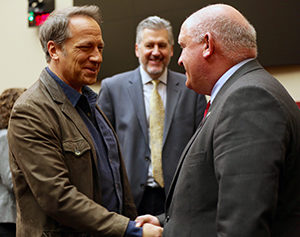Businesses, schools and other stakeholders must do a better job of highlighting job opportunities in career and technical fields, advocates said this week at a House panel hearing.
Glenn Johnson, manufacturing workforce development leader at BASF Corp., noted that his company’s awareness efforts of career and technical education is “our approach to increase the size of the workforce pipeline.” It’s a serious issue not only for BASF, but for all manufacturers, especially as baby boomers begin to retire, he said.
Surveys indicate that more than half of all teenagers say they have no interest in a manufacturing career, Johnson said in his testimony before the House Subcommittee on Early Childhood, Elementary and Secondary Education on Feb. 28. However, the reports also cite that the most influential factor for students deciding what career to pursue is personal experience, meaning what they have been exposed to.
“This drives our need to do more to familiarize these workforce potentials with jobs in manufacturing technology,” Johnson said.
Since 2010, more than 380,000 K-12 students have participated in science education programs offered by BANF, he said. The company also is involved at the postsecondary level by providing on-the-job experiences and scholarships to students. For example, it is hosting tours and site visits for students and faculty of the Lamar Institute of Technology and Lamar State College in Texas. It’s also working with Rover Parishes Community College in Louisiana to pilot one of the state’s first accelerated process technology degree programs. In addition, BANF has donated equipment and funds for scholarships to other public two-year colleges, such as Lee College, San Jacinto College, Lone Star College and Brazosport College.
BANF wants to assure that these programs are not just “books and lectures,” but that they include hands-on lab activities that mimic job performance, Johnson said.
“These programs must go beyond teaching theory and information,” he said. “They must teach skills that can be directly applied on the job immediately.”
The benefits of dual enrollment
Janet Goble, director of CTE in Utah’s Canyons School District, echoed the need for business partnerships and work-based learning opportunities. Community colleges’ have role, too, she said, noting her district offers 44 CTE dual-enrollment courses with Salt Lake Community College (SLCC) and two local universities. She highlighted its partnership with SLCC and industry in developing a statewide diesel technology pathway that includes dual-enrollment students.
In addition, the college has teamed with companies in the medical device manufacturing field to offer a new medical innovations pathway this fall. SLCC created a similar program for adult learners interested in that career path.
Breaking barriers
The speakers noted that CTE continues to have a stigma attached to it. Again, overcoming it requires informing students and their parents of the benefits. Students who earn a CTE-related associate degree or certificate can make an average of $9,000 more annually than their peers who graduate with a humanities or social science focus, said Mimi Lufkin, executive officer of the National Alliance for Partnerships in Equity. Students in postsecondary CTE programs are also more likely to be employed within five years than those in an academic field of student.
Mike Rowe, CEO of the mikeroweWORKS Foundation and television host of “Dirty Jobs” and “Somebody’s Gotta Do It,” agreed that the bias against CTE continues. He noted that he has previously spoke before congressional panels with little, if any changes, since then.

Mike Rowe, TV personality and CEO of the mikeroweWORKS Foundation, chats with Rep. Glenn Thompson, R-Pennsylvania. (Photo: House Education and the Workforce Committee)
“The skills gap widened. Unemployment grew. And society continued to ignore thousands of opportunities that comprise a critical part of our workforce,” he said.
Rowe noted that President Donald Trump’s trillion-dollar plan to revamp the nation’s infrastructure simply cannot happen without a trained workforce. He added that he was happy to hear manufacturing CEOs convey to Trump last week that their top concern wasn’t a lack of jobs but lack of skilled workers.
“There’s a powerful and logical assumption that unemployment can be remedied with more opportunity,” he said in his testimony. “But the skills gap proves that opportunity is not enough to get people working.”
Reworking Perkins
The speakers also noted the importance of the federal Perkins Act in supporting CTE. Subcommittee Chair Rep. Todd Rokita (Indiana) observed that legislation to revamp Perkins — which hasn’t been updated for more than a decade — passed in the House last year but didn’t advance.
“The important reforms in that legislation would empower state and local leaders to respond to changing education and economic needs,” he said. “They would support innovative learning opportunities for students and help build better community partnerships, including stronger engagement with local employers.”

